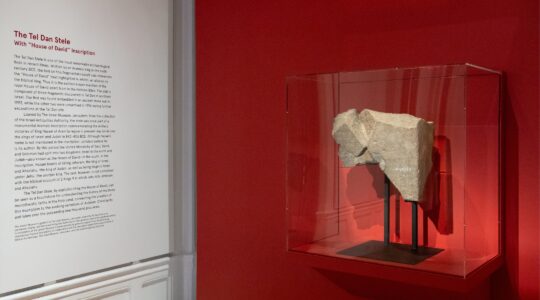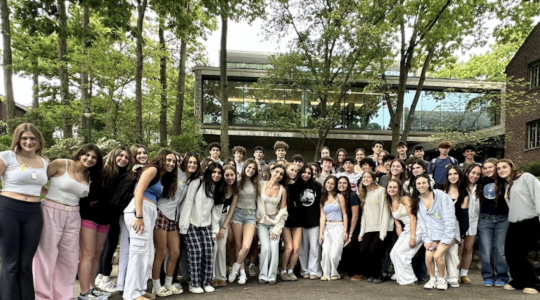“The Lord said to Moses, ‘Speak to Aaron and say to him, ‘When you set up the lamps, see that all seven light up the area in front of the lampstand.’”
[Numbers 8:1-2]
This week’s biblical portion contains an important insight into the necessary qualities and major functions of our rabbis. Our Torah reading of last week, Naso, concluded with the various offerings of the princes of the tribes at the dedication of the desert Sanctuary, forerunner of the Holy Temple in Jerusalem.
Beha’alotcha begins with the kindling of the menorah, the seven candlestick branches made of pure gold, each culminating in a golden flower with three branches emanating from either side of the central tree-like branch, and seven flames spreading warmth and enlightenment within the most sacred area and beyond. The operative verse that describes this magnificent accoutrement is “the candle is commandment, and Torah is light” [Proverbs 6:23].
Rashi, the classical biblical commentator, is apparently disturbed by the placement of the menorah in our portion: It seems to have belonged in the Book of Exodus, which describes the inner furnishings of the Sanctuary, including the menorah [Exodus 25:31-40]. Rashi therefore opens his interpretation of our portion with the words of the Midrash [Tanhuma 5]:
“Why this juxtaposition of the description of the lighting of the Menorah with the offerings of the Princes of the tribes? It is because when Aaron saw the dedication of the Sanctuary, he became upset that he had not been included in the dedication offerings and ceremonies; neither he nor his tribe of Kohanim. The Holy One Blessed be He said to him, ‘By your life, your contribution is greater than theirs; you will kindle and clean the candlesticks.’”
What was so special about kindling the menorah? It happened early in the morning, without audience or fanfare, and seemed like an almost janitorial duty of turning on the lights.
I would suggest that there were two central furnishings in the Holy of Holies, the inner sanctum of our Sanctuary: the sacred ark, which housed the Tablets of Stone, and the menorah. The former, with the Torah in splendid seclusion behind the curtains, was meant for Israel alone, to form a “holy nation”; the latter, with its warmth and light spreading all around, was the Torah meant for the world, the Torah which would go forth from Zion, the word of the Lord which would emanate from Jerusalem to the nations.
The Midrash [Mekhilta de Rabbi Yishmael, Parshat Yitro, Parsha Aleph] teaches that the Revelation at Sinai was given in a desert, rather than on the Temple Mount, in order to teach us that the Torah was not meant for the Jews alone, but rather for all of humanity. Just prior to the Revelation, Israel is charged by God to be a “Kingdom of Kohanim,” teachers to all of humanity [Seforno, ad loc Ex. 19:6], purveyors of a God of love, compassion, morality and peace. This universal charge is given to the Jews to become a sacred nation, a nation of Kohanim to convey our teaching to the world [Isaiah 2, Micah 4, Zechariah 7-9] — otherwise, they would hardly be an example to emulate. This is the true significance of the Kohen’s kindling of the menorah.
It is our duty to demonstrate to the world that we have righteous decrees and ordinances [Deuteronomy 4:8], and it is our laws, our unique lifestyle, which now that we have our Jewish state, we must share with the world [Deut. 26:18-19]. Whether it is the Kohen Gadol in the days of the Messiah, or the rabbis and Jewish educators today, we must convey these righteous laws which will inspire the rest of the nations to accept our God of compassion and peace. They must be our ambassadors to the world, bringing the light and the warmth of Torah to all the families on earth [Genesis 12:1-3]. They must kindle the menorah.
It is not by accident that the menorah is shaped like a tree, which grows and produces fruit. It is a symbol of halacha, a progressing and moving teacher of morality and sensitivity. How we treat the stranger and would-be convert, how we deal with the hapless woman chained to a recalcitrant husband who won’t let her go, is the test of the justice of our laws and the fitness of our rabbis to be our decisors; our Torah must be righteous and compassionate.
Rabbi Shlomo Riskin is the chief rabbi of Efrat, Israel, and chancellor emeritus of the Ohr Torah Stone network of schools.
Support the New York Jewish Week
Our nonprofit newsroom depends on readers like you. Make a donation now to support independent Jewish journalism in New York.
Candlelighting, Readings:
Candlelighting: 8:10 p.m.
Torah reading: Numbers 8:1-12:16
Haftorah reading: Zechariah 2:14-4:7
Shabbat ends: 9:18 p.m.
The New York Jewish Week brings you the stories behind the headlines, keeping you connected to Jewish life in New York. Help sustain the reporting you trust by donating today.




